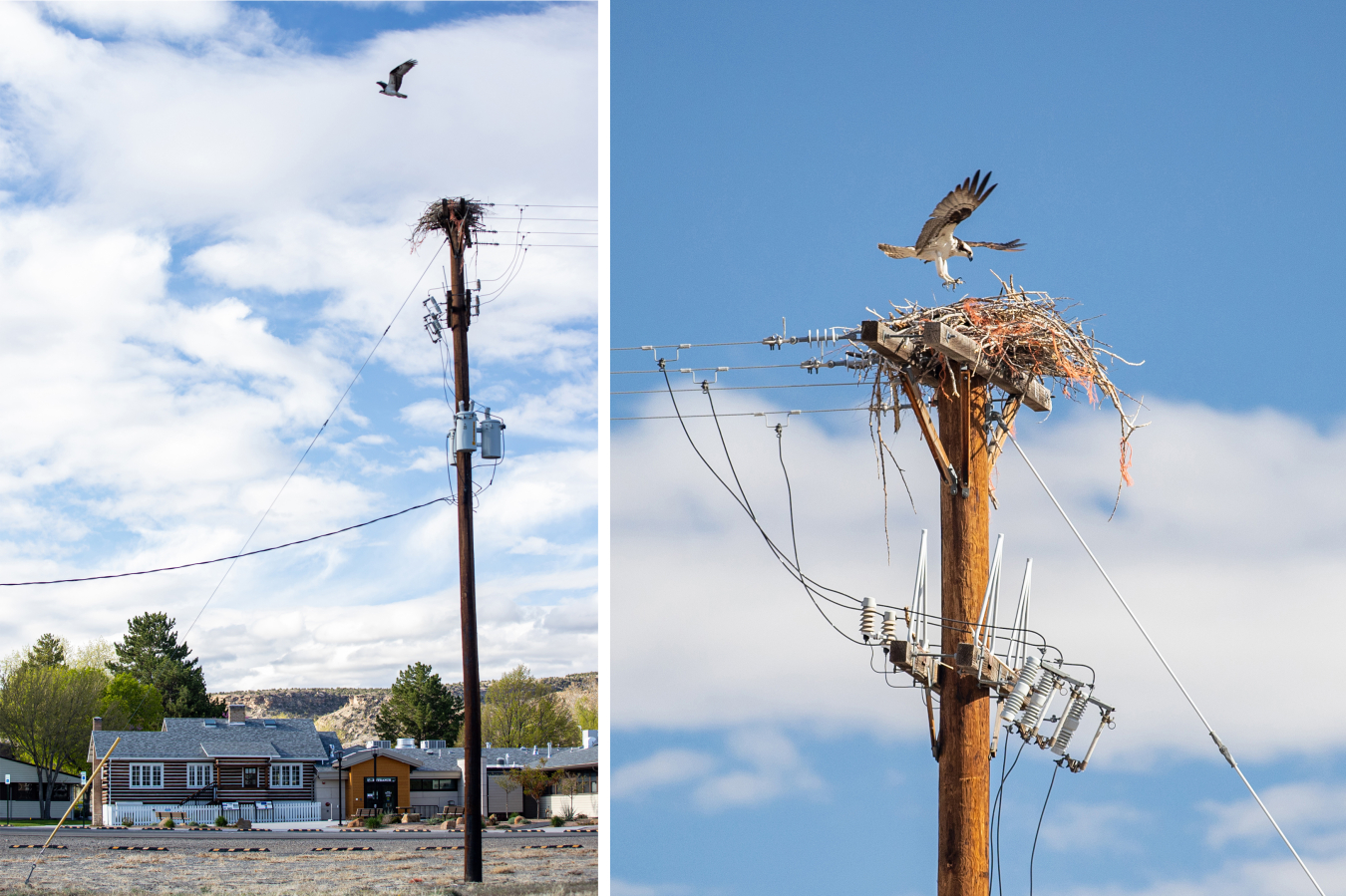A mating pair of ospreys made a nest high above the Atomic Legacy Cabin.
August 9, 2021A mating pair of ospreys made their nest high above the U.S. Department of Energy (DOE) Office of Legacy Management (LM) Atomic Legacy Cabin about two months ago and the fledglings have hatched.
“At the Grand Junction LM office, we are excited these birds have decided to call our office location home,” LM Public Participation Specialist Shawn Montgomery said. “We hope they’ll be back next spring.”
The male usually selects a nesting site from a variety of settings – a dead tree, a cliff, or a human-made structure (such as an electrical pole on the LM office site) – near water. The osprey collect sticks and other nesting materials and the female arranges the sticks into a large and bulky nest. Ospreys are monogamous birds that mate for life and are devoted parents.
For the past month, the female sat on her eggs, which are predominately creamy white with brown blotches. Meanwhile, the male protected her while also hunting and bringing back food to the nest.
“Osprey chicks hatch with a layer of very thin down feathers, called the ‘first down,’ and they lack the striking yellow eyes exhibited by their parents,” LM Strategic Partner Ecologist Zack Schuler said. “The chicks are not super cute during their first few days of life. As they mature, they begin the process of replacing their down feathers. After about 10 days, the first down is replaced with a second down coat and, later this second down coat is replaced with true feathers.”
The young ospreys will have a characteristic black stripe near their eyes and charcoal-and-white feathers. Usually, a fledgling’s eyes are orange or brown until adulthood, when their eye color changes to yellow. Ospreys mature after two years of age. As they age, their gender becomes more identifiable; like other birds of prey, osprey females tend to be larger than the males. Like all raptors, osprey have a high mortality rate in the first year of life.
Osprey young will remain with their parents for up to two months after hatching. The mother stays with her young continuously at first, sheltering them from sun and rain. The father brings fish to the nest, and the mother feeds the young.

A mating pair of ospreys made a nest high above LM’s Atomic Legacy Cabin about two months ago and the fledglings have hatched. Birdwatchers are welcome to park on the south side of the Atomic Legacy Cabin’s parking area and view the birds with binoculars or spotting scopes from a safe distance. Birdwatchers are reminded to exercise caution and restraint when photographing, recording, or approaching birds.
As the summer continues, osprey parents will conduct flying and hunting lessons for their young. The young birds make their first attempt to fly around 51-54 days after hatching.
Ospreys have excellent vision. The birds can detect underwater objects from the air and can spot their prey from more than 130 feet above the water. The birds hover momentarily and then plunge feet first into the water. Ospreys catch fish by diving into a body of water, sometimes submerging their bodies entirely.
The osprey parents will have only one brood per year. The young hatchlings will likely remain in the same area of their birth for two or three years, using it as their wintering grounds, before flying north to find a mate. When young ospreys migrate on their own, they instinctively know where to go without parental guidance. Ospreys are migratory and travel south for long distances — sometimes as far as Central and South America – where they spend the winter.
The U.S. Fish and Wildlife Service recommends following the American Birding Association’s ethics and guidelines while bird watching, which states:
Avoid stressing birds or exposing them to danger. Be particularly cautious around active nests and nesting colonies, roosts, display sites, and feeding sites. Limit the use of recordings and other audio methods of attracting birds, particularly in heavily birded areas, for species that are rare in the area, and for species that are threatened or endangered. Always exercise caution and restraint when photographing, recording, or otherwise approaching birds.
LM ecologists would like to remind visitors to respect the nesting ospreys. Birdwatchers are welcome to park on the south side of the Atomic Legacy Cabin’s parking area and view the birds with binoculars or spotting scopes from a safe distance.

